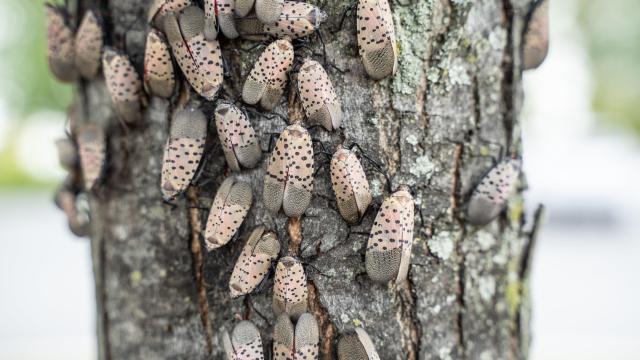Everyone’s favourite squishable pest—the spotted lanternfly—might be less of a nuisance than we thought, new research suggests. The four-year-long study found that the insects caused little to no long-term damage to a variety of different tree species. The authors say the invasive bugs should still be carefully managed to limit their potential harm, but also that the general public should have less to fear from seeing them in their backyards.
The spotted lanternfly (Lycorma delicatula) is native to China. It’s been in the U.S. since at least 2014 (when it first was spotted in Pennsylvania) and has now spread to over a dozen states across the Eastern U.S. The bug is mainly feared for its voracious and diverse appetite since it can feed on the sap from a large range of fruit, ornamental, and woody trees. After feeding, the distinctly colourful adult lanternflies also leave behind a sugary waste product called honeydew that can attract other pests and promote the growth of potentially harmful fungi. And because the lanternfly has no native predators here, populations can easily spiral out of control.
The bugs have quickly become a widely hated public menace, with scientists and environmental agencies now annually encouraging residents to smash them on sight. But according to researchers at Penn State University, there’s still much we don’t know about their potential environmental impact in the U.S. To better understand the risk, the team conducted a lengthy study.
The scientists regularly exposed four species of trees (the silver maple, willow, river birch, and tree of heaven) to lanternflies and observed what happened to them over the course of four years. They also compared these trees to uninfested controls.
As other research has shown, the team found that the heavily infested trees fared worse on average than the controls and lightly infested trees early on. The roots of these trees often showed an impaired ability to photosynthesize and reduced growth, for instance. But by year three, many of the trees had started to recover as the population of lanternflies declined. By the end of the study, the only species clearly showing a continued lack of growth was the tree of heaven, which is known to be the bugs’ preferred tree. But even these trees, which are themselves an invasive species, didn’t die off.
The team’s research, published last month in the journal Environmental Entomology, was intentionally designed to represent a worst-case scenario, according to study author and Penn State entomologist Kelli Hoover. So it’s possible that these bugs are causing even less damage to trees in the real world than what they observed.
“In nature, the nymphs and adults move often, so the degree of reduced growth we saw in our study is unlikely unless the insects stay on the trees for months,” Hoover told Gizmodo in an email. “So, yes, I would say that the spotted lanternfly is not as dangerous to hardwood trees, other than tree of heaven, in most cases, as we feared.”
This is only one study, so its conclusions should ideally be validated by other scientists. Other evidence has also suggested that the greatest harm posed by these bugs in the U.S. isn’t so much to trees but to important agricultural crops, particularly grapes. Since its arrival, for instance, several grape vineyards and winery owners have reported massive production losses attributed to the pests.
For their part, Hoover’s team isn’t arguing that the spotted lanternfly poses no risk to trees at all.
“The biggest threat the spotted lanternfly presents to forests is laying eggs on trees that could be used as timber or they may lay eggs on cut logs at a sawmill. So the timber industry still needs to watch for these insects when they are moving any wood out of quarantine, but of course, they already do that,” Hoover said. “Production nurseries will still want to manage SLF on potential hardwood host trees to prevent any reductions in growth or tree health.”
But, she added, “for the general public who have spotted lanternflies on trees in their yard, don’t panic. Chances are good that no lasting damage will occur…Personally, even if the red maples in my yard were covered with spotted lanternflies, I wouldn’t use insecticides on my trees. However, if any egg masses show up, I’d scrape them off into a plastic bag of isopropyl alcohol to kill them.”
Hoover also isn’t looking to spoil anyone’s bug-squishing fun, though it’s probably not doing too much to rein in their numbers.
“Stomping on them will kill them and make us feel better about doing something, but I’m not sure this is sufficient to reduce populations to a great extent,” she said.
